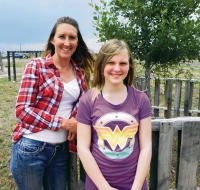
Teen diagnosed with Complex Regional Pain Syndrome begins treatment program with help of community
For 12-year-old Emma Harrington a fractured ankle revealed a more complex and painful medical condition. Emma is a bubbly preteen. She is sweet, pretty and has a pleasant personality. She loves 4-H activities, her animals and her youth group at Sunset Church of Christ. But Emma is in constant pain.
Emma, daughter of Amanda and Mike Harrington, suffers from Complex Regional Pain Syndrome or CRPS. This is a medical condition where long–lasting unbearable pain is experienced. It usually begins in a limb and can migrate throughout the body. Burning, stabbing or shooting pain is often felt. CRPS may occur after trauma, but in children and teenagers, it may occur with little or no injury.
Emma was diagnosed with the syndrome in January, although she has been dealing with the pain since October when she fractured her left ankle in three places. The fractures were non-displaced fractures (broken pieces still in alignment), her mother explained. Emma said she was speed walking through the living room and her foot hit a wood strip on the couch.
“The swelling was bad and the discoloring was also bad,” said Amanda Harrington, noting that two days after hurting her foot she was in excruciating pain.
“It has never gone away,” Emma said.
It was a month before they knew about the fractures. Her mother said that she got in to see a local foot specialist after a local orthopedic specialist refused to see her because of a past misunderstanding. The foot specialist ordered an MRI. Although he knew what was wrong, he sent Emma to a pain specialist in Lubbock for a diagnosis…continue reading
So sorry to hear of someone so young. It’s very fortunate though to have received a diagnosis so quickly, as it’s not uncommon for many of us in a similar situation to go years bouncing from doctor to doctor with no diagnosis.
My thoughts and wishes go to Emma and her family.
















